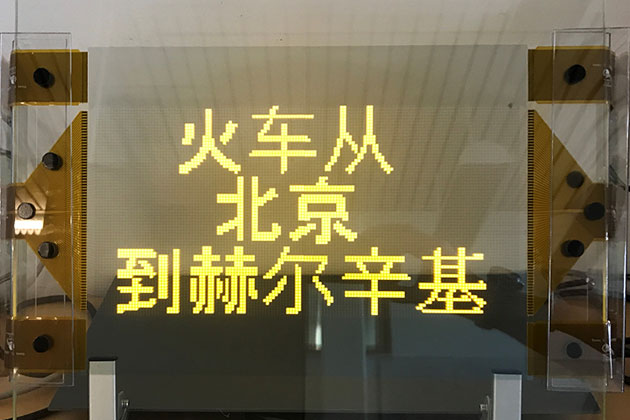The Lumineq® ELT160.60.100-07NC display (a.k.a. the “.100”) is a transparent thin film electroluminescent matrix TASEL® display without a cover glass (=NC) made for transparent TFEL technology with a substrate thickness of 0.7 mm. Its primary purpose is to serve as a transparent display in window laminates, e.g. windshields.
Prototyping with the Lumineq .100 matrix display
The ELT160.60.100-07NC display is an especially powerful tool for prototyping in-glass-laminated displays, as its contents can be changed programmatically through its versatile SPI interface, in contrast to fixed-content segmented transparent displays.
In this blog we go through the necessary steps of making an animated demo with the .100 display.
But before we do this, a word of caution:
Lumineq displays run with high voltage through their flex (FPC) cables and provided with no boxing or chassis (as it is up to the customer do make the prototype installation). When running the displays, do not touch any part of the display, cabling or driving electronics, and perform the trials on an electrically non-conducting surface.
Basic principle
The basic principle of making an animation in the .100 display is to create a stack of monochrome bitmaps that are converted to SPI compatible binary files, which are then sent to the .100 display one by one to create an animation loop. The display’s control electronics provide a full SPI interface for data input for real-life applications, and to generate SPI signals from a computer, a small utility product called “ELT160.60.100-07NC Demo Kit” is needed.
Generating the animation
To make the SPI commands necessary to run the animation, you'll first need to convert a series of monochrome bitmaps with exactly 160 x 60 resolution into binary files. Monochrome bitmaps are needed as the .100 display is only capable of turning the pixel fully on or fully off. Black in the monochrome picture is translated into a pixel which is on, and white to a pixel which is off. For driving the displays, the monochrome bitmaps need to be translated into their SPI counterparts, which is very easy with the Demo Kit software utilities. For more information, see the Demo kit documentation.
Test run the metro / subway
The demo kit includes scripts e.g. a metro animation that you can run. When the display is properly connected, you can launch the animation simply by typing “subway” at the command prompt, in the subway demo folder. A cute little subway train should appear and start moving on the display.
There's also a snake animation if you get carried away, reminiscent of the famous snake game of the historical (if you can call 20 years a history!) mobile phones.
Lumineq matrix display introduction packages
Lamination Introduction Package for the ELT160.60.100 Transparent Matrix Display
TASEL® Introduction Package for the ELT160.60.100 Transparent Matrix Display
Transparent Lamination-Proof Matrix Display ELT160.60.100-07NC (a.k.a. the ".100")
